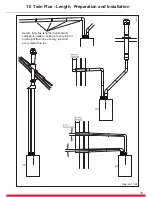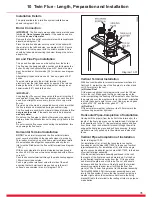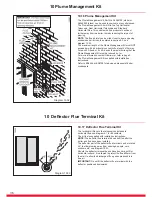
35
10 Twin Flue - Length, Preparation and Installation
Diagram 10.31
12985
Installation Details
The parts available for a twin flue system installation are
shown in diagram 10.30.
Boiler Connection
IMPORTANT
: The flue seals are sensitive to mineral oil based
lubricants.
Do not grease the seals
. If the seals do need to
be lubricated
use
only water
.
Remove the top flue outlet cover complete with resonator and
discard, see diagram 10.4.
Place the twin flue adaptor onto the outlet of the boiler with
the air inlet to the left hand side, see diagram 10.31. Secure
the adaptor to the top panel with the screws provided. Care
should be taken when inserting the screw through the hole in
adaptor top.
Air and Flue Pipe Installation
The air and flue pipes can now be built up from the boiler.
The flue must be designed with a continuous fall towards the
boiler. If using the horizontal flue pipe or 90° bends the pipe
must be inclined at 44mm/metre (2.5°)
minimum, see diagram
10.29.
Alternatively if space allows, use 45° bends in place of 90º
bends.
To aviod rain ingress to the air Inlet terminal, it is good
practice to aim the inlet downwards by approx 2° as rain can
damage the boiler. The Flue outlet pipe must always run at
44mm/metre (2.5°) back to the boiler.
IMPORTANT
:-
Long lengths of flues must be secured to the wall or ceiling it
runs against. Use at least one fixing bracket on each flue joint
used or on straight flue runs every joint and for every metre
flue run.
Provision must be made in concealed boxing or ductwork that
the flue joints can be inspected during annual servicing.
The flue seals are sensitive to mineral oil based lubricants.
Do
not grease the seals
. If the seals do need to be lubricated
use
only water
.
Do not use the flue pipe to attach other pipes or equipment. If
visible, advise the householder not to hang or clip items to flue
pipes.
Do not stress the flue connections during the installation, this
can damage the flue seals.
Horizontal Terminal Installation
NOTE:
The air inlet terminal and the flue outlet terminals
must never be installed on the opposite sides of a property.
Termination must only be on the same wall or adjacent walls.
When installed close together separated vertically, the air
inlet must be fitted below the flue outlet terminal (see diagram
10.29).
With due consideration to terminal clearances mentioned in
section 4.2 drill the one or two holes as required with a 90mm
core drill.
Push the horizontal terminal through the wall allowing approx.
100mm to protrude outside.
Push a grey rubber wall seal onto either side of the wall
ensuring that both wall seals are pushed up to the wall
surface, see examples (b) and (c) diagram 10.29.
Vertical Terminal Installation
With due consideration to terminal clearances mentioned in
Section 4.2, project the rise of the flue pipe to roof level and
cut 150mm hole in the roof.
(a) Pitched Roof
Fit the required pitched roof weather collar over the 150mm
hole in the roof. Make good the tiling or slating around the
collar incorporating the flashing of the weather collar. Position
the angle cap over the weather collar in the correct orientation
to attain the correct angle for your roof. One way round gives
a pitch of 25°-38° and the other gives 37°- 50°.
(b) Flat Roof
Fit the aluminium weather collar over the 150mm hole in the
roof ensuring a weather tight seal.
Horizontal Pipes-Completion of Installation
Having built the pipe(s) from the boiler to the terminal(s), the
length of the final pipe piece can be determined. Cut pipes at
the opposite end to the ‘O’ ring seal making square and free
from burrs. Push the horizontal terminal through the wall to
engage the final pipe piece and pull back ensuring the grey
wall seals are fully pulled up to the outside and inside wall
faces.
Vertical Pipes-Completion of Installation
Refer to diagram 10.29.
For installation of (a), attach the twin pipe to concentric
flue adaptor, part number A2011600, to the base of vertical
terminal assembly. For installation of (b), attach the single
pipe to concentric adaptor, part number A2011500, to the base
of vertical terminal assembly.
With the vertical terminal assembly positioned in the roof,
the length of the final pipe can be determined. Cut the flue
to the desired length measuring from the ‘O’ ring seal end
and discard the plain end of the tube. The cut end should
be square and free from burrs. Carefully push the terminal
assembly upwards to allow room for fitting the final flue
piece(s). Fit a 100mm fixing bracket to the terminal assembly
Part No2000460486. Pull the terminal assembly down and
join to the flue system. Ensure that the terminal is making a
weather tight seal on the weather collar. Secure the fixing
bracket fitted to the terminal to the roofing struts or a purpose
made batton.
Summary of Contents for 24cx
Page 13: ...13 5 Water System Heating Diagram 5 3 13102 Diagram 5 4 13925 13072 Diagram 5 2 ...
Page 15: ...15 H H Boiler Securing Screw 6 Installation Preparation Diagram 6 1 12778 ...
Page 20: ...20 9 Safety Discharge Valve and Condensate Connections Diagram 9 2 13000 ...
Page 48: ...48 14 Fault Finding 14516 Diagram 14 4 MODE ...
Page 49: ...49 13012 Diagram 14 5 CENTRAL HEATING DHW 13015 14 Fault Finding ...
Page 50: ...50 14 Fault Finding 14027 Diagram 14 6 FAULT CODES ...
















































